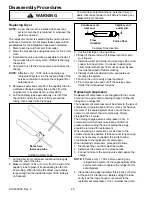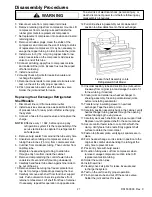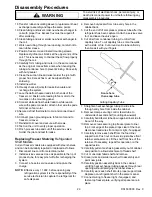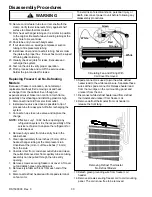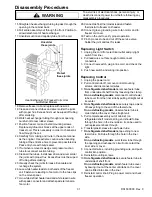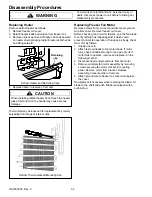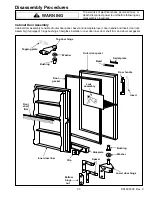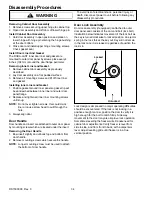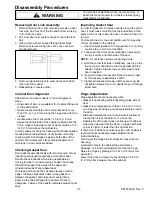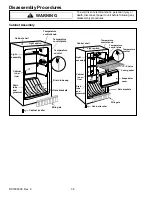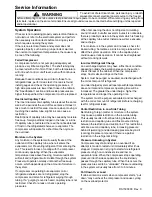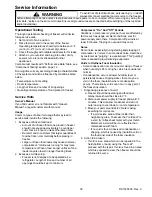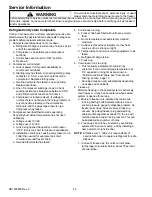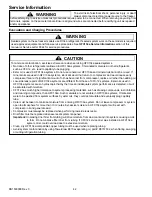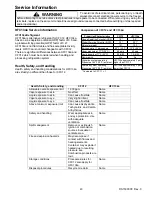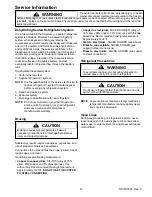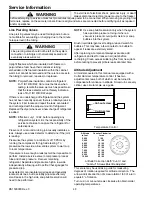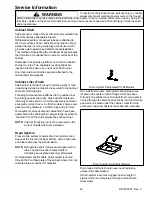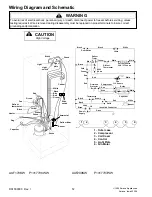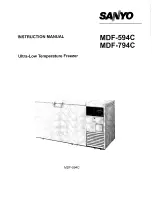
RS1500000 Rev. 0
40
Service Information
To avoid risk of electrical shock, personal injury, or death,
always disconnect electrical power source to the freezer
before attempting to service unless test procedures require power to be connected. When removing any wiring from
terminals, replace on the same terminals. Ensure all ground wires are connected before certifying unit as repaired
and/or operational.
WARNING
!
Refrigeration System Complaints
Common occasions for customer requesting service are
listed below with possible reasons and tests to diagnose
problem before replacements are made.
1. Cabinet temperature does not come down:
a. Refrigerant charge is low. Examine frost line at tail
end of the evaporator.
b. Compressor is inoperative (see compressor
sections).
c. Control has been turned to "OFF" position.
d. Freeze-up
2. Compressor will not start:
a. Lack of power. Verify power availability at
compressor terminals.
b. Starting relay has failed. Connecting starting relay
contacts L & S for 1 second should result in a
normal start. Replace starting relay.
c. Overload protector has failed in open position.
Replace overload.
d. One of compressor windings is open. Check
winding resistances. Resistance between CDS
and CDR should be less than 100 ohms.
e. Compressor is locked (seized). If voltage is
normal, there is no failure in the relay protector or
any connections leading to the compressor
terminals, and the amperage drawn is high.
Compressor has failed.
3. Compressor overload thermostat is operating
frequently but cabinet temperature has not risen
noticeably.
a. Voltage under 10 VAC.
b. Voltage over 127 VAC.
c. Lid is being opened frequently so compressor
"OFF" time is too short for pressure equalization.
d. Installation condition is causing compressor to run
hotter than usual (for example, lack of air
circulation around freezer shell).
e. Overload thermostat has failed.
4. Continuous running:
a. Freezer has been filled with unfrozen or warm
food.
b. Room temperature exceeds recommended
maximum.
c. Cabinet is placed near radiator or other heat
source, such as strong sunlight.
d. Temperature control is incorrectly adjusted or has
failed.
e. Refrigerant charge is low
f. Freeze-up
5. Compressor runs too long:
This is usually a statement of opinion by
customer. For a normal storage temperature at
0°F, expected running times are shown in
"Performance Data" table, see "Component
Testing" section, page 12.
Running times can vary substantially depending
on usage and conditions.
6. Freeze-up:
Moisture freezing in the sealed system is extremely
rare; however, it may be encountered when sealed
system is opened for service.
a. Moisture freeze-up is indicated by continuous
running and high cabinet temperatures. Use a
suction pressure gauge to diagnose problem. As
freezer pulls down, back pressure drops to a
vacuum. By pulling freezer plug and warming
cabinet until evaporate exceeds 0°C the ice will
melt and cause a rapid rise in pressure. This can
be duplicated any number of times.
b. Freeze-up can only be corrected by evacuating
system with a vacuum pump, and by installing a
new, oversized, high side drier.
NOTE:
Effective July 1, 1992, it is responsibility of
service technician to capture refrigerant for safe
disposal.
c. In case of freeze-ups, the unit's current draw
(amperage) will usually be low, about 70 percent
of serial plate.

